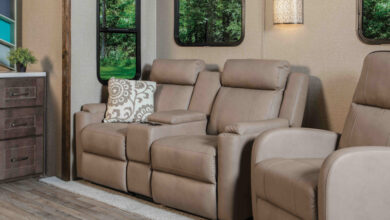Eye on Driving Safety

A driver getting behind the wheel of a sedan, SUV or pickup faces the risk of blind spots and other collision hazards. Those risks multiply exponentially when the driver is piloting a 40-foot diesel pusher.
So perhaps it’s no surprise that a company that’s been providing advanced driver-assistance systems (ADAS) in the automobile and fleet markets for nearly two decades has expanded its reach in the North American motorhome market during the past six years.
Offering the company’s product to the RV market has been a natural progression for Mobileye, which was founded with a vision of offering vision-safety technology designed to make roads safer, reduce traffic congestion and save lives, according to Steven Wenger, one of the company’s business development managers for its New York-based North American operation.
Mobileye, a division of Silicon Valley tech giant Intel, now counts a dozen RV manufacturers as customers. The Mobileye system is offered as standard equipment on some higher-end models and as an option on others, Wenger says.
And, with authorized Mobileye dealers around North America, it’s a device that also offers an attractive option for current RV owners who would like to upgrade their units to the same level of safety they may already have in their truck or car.
A Vision of Safety
These days, it’s rare to see ads for popular automobile models that don’t include references to forward-collision or lane-departure warning systems among their safety features.
Those capabilities are based on technology that’s been under most people’s radar until recently, which is not to say they are brand new. Mobileye Vision Technology, an Israeli company, was incorporated in 1999 by founders Amnon Shashua and Ziv Aviram, and for more than a decade the company has been at the forefront of using vision safety technology to make the driving experience safer for consumers, Wenger says.
Today, the company partners with some 27 automotive OEMs worldwide.
Mobileye was purchased by Intel late in 2017, but its headquarters remain in Jerusalem, as does much of its research-and-development team. Wenger says the company does business in 45 different countries and employs more than 600 people.
And while Mobileye’s technology could be described as futuristic, the company is hardly resting on its laurels, says Wenger, who notes that the company expects it will play a role in the future development of autonomous (driverless) vehicles.
“The future is autonomy,” he says. “There are still many things that need to be accomplished to get there, but the road leads from ADAS, and we can be a big part of the quest for self-driving vehicles.”
In the meantime, the company’s current vehicle safety system enjoys a prominent position in the automotive and RV industries. At the heart of the Mobileye system is what some people refer to as a camera, although Wenger prefers the term “vision sensor,” which is mounted on the front windshield.
“This device is a very advanced camera, if you will, capable of processing images as fast as 50 frames-per-second and interpreting the scene through the use of the sophisticated algorithms in the company’s EyeQ chip,” Wenger explains. “From its place on the windshield, it identifies cars, trucks, motorcycles, bicycles, pedestrians, lane markings, speed limit signs and even in construction zones. It also has the ability to determine if the ambient light is low and – if there are no headlights or taillights in front – it will activate the high beams.”
In addition, the Mobileye system will monitor the distance in seconds from the vehicle in front and warn when the time becomes critically short; warn of an imminent collision with a pedestrian or cyclist; and notify the driver whenever the vehicle exceeds the posted speed limit. As a result, Mobileye meets the National Highway Transportation Safety Administration’s (NHTSA’s) guidelines for forward-collision and lane-departure warnings.
The information is conveyed to a display mounted on the dash that provides visual alerts and auditory warnings that emit on the backside of the vision sensor.
Another feature, available in OEM-installed systems, is what Wenger calls “cruise defeat.”
“Once the Mobileye unit has determined a danger zone, which is set by the driver, and the vehicle is in cruise-control mode, it will disengage the cruise control until that danger zone has disappeared,” he explains. “Then, the driver will need to re-engage the cruise control.”
Wenger says that both cruise defeat and the high-beam control are not part of the standard features available on the Mobileye version sold through Mobileye dealers, and will require additional parts and labor.
“This is not a DIY-type product,” he stresses.
Vertical Expansion
Wenger, who is based in Grand Rapids, Mich., says for most of the past six years, his focus has been expanding Mobileye vertically within the RV market.
“Over that time, we’ve grown from essentially one manufacturer to currently a total of 12 manufacturers, he says. “That’s pretty good growth over a short period.”
He acknowledges that at present Mobileye can be perceived as a premium product and is most likely to be found on Class A motorhomes.
“There are now a few Class B vehicles that receive a Mobileye unit from the factory,” he says. “That isn’t necessarily the case with Class C units, because that’s more of a budget-minded market, so the room for this type of technology from the OEMs’ standpoint isn’t necessarily there.”
That’s certainly not set in stone, though. While Winnebago Industries and Tiffin Motorhomes were among the first to adopt Mobileye for their higher-end units, last year the company added REV Group to its list of clients and also OE parts distributor River Park.
“They’ve incorporated Mobileye as part of a package similar to what the automotive industry is doing if you buy a premium package that might include heated leather seats, an upgrade from a four-cylinder engine to a six-cylinder engine, on-board navigation, that kind of thing,” Wenger says. “In an RV, you might get an upgraded sound package, a couple other upgrades and then Mobileye technology.”
And, while the manufacturers of higher-end motorhomes that are building their own chassis need to make the decision to design a wire harness for Mobileye into their units, Wenger adds that his company also has alliances with Freightliner and Spartan Motors to provide such a wire harness on their respective chassis.
An owner of an older RV who may become aware of the safety feature with the purchase of a new car or SUV also can add it to that unit thanks to a network of some 250 Mobileye dealers throughout North America.
Because of Mobileye’s appeal across several markets, the company requires that authorized dealers must be retailers specializing in vehicle electronics or – in the RV market – RV-related accessories. Wenger says they must also be able to provide a complete solution to the consumer, meaning they’re not simply going to sell the units, but offer onsite installation by a trained and certified technician.
He adds that the company offers a complete web-based training and certification course. The final requirement: Dealers must purchase the two proprietary calibration tools required.
“Because every vehicle is different in its shape, size and physical dimensions, that’s a very important part of the calibration process and the vehicle’s architecture,” Wenger says. “We want to make sure the installer is well-trained and knows the process extremely well so the Mobileye unit functions as we state.”
Building a Success
Whether it’s part of a brand-new unit rolling off the assembly line or an aftermarket purchase, Wenger says the company has one good tool for selling Mobileye into the RV market: Its increasing presence in cars, trucks and SUVs.
Early on, that wasn’t the case. So, to educate RV owners, Mobileye aligned itself with the Family Motor Coach Association, as well as participating in numerous rallies.
“The main purpose for that strategy was to exhibit the product,” Wenger says. “I also conduct seminars on a regular basis to tell people this technology exists. Now, we’re finding that if they have it in the car they drive today, they want the same type of technology in their RV.”
That certainly is carrying over into the aftermarket, where Wenger says interest continues to build among existing RV owners who wonder how they can add the technology to their units.
“We like to tell RV dealerships they can diversify their businesses, especially because our product is so strong in the safety category, which generates large interest,” Wenger says. “We’ve had dealers come by our booth when we exhibit asking how they can be a part of our program, and I think in 2018, the smart dealer who’s having customers ask if he offers Mobileye is going to say, ‘We don’t offer it yet – but we can.’”
Perhaps not surprisingly, Wenger notes that year-over-year growth with Mobileye in the RV market is in the 25 percent to 30 percent range. Still, he says the biggest challenge he continues to face is people’s lack of awareness of the product.
“It’s gotten better, but there’s a lot of room to grow,” he says.
Mobileye’s biggest advantage, Wenger believes, is its strong presence in the automotive market, and the fact that the Mobileye technology sold into the RV industry is similar to what others (the company estimates it’s sold some 32 million units worldwide) are already relying on with their daily transportation.
And, while it’s not an inexpensive product, pricewise, the use of vision-based technology – rather than the radar-based systems some high-end RV manufacturers are installing – makes it attractive, according to Wenger. So, does the technology itself, he adds, while noting the main drawback is that it works much like the human eye.
“When we struggle as humans to see something, it’s in conditions such as heavy downpours of rain or dense fog,” Wenger says, adding the Mobileye unit has that same challenge. “We even have a feature that references limited visibility, giving an indication to the driver on the display.”
Looking ahead, Wenger believes future growth within the RV market will be primarily horizontal, as he says vertically Mobileye already covers a large swath of the marketplace.
“In three to five years, Mobileye won’t be an option; it will be standard on just about every vehicle being built for the RV market,” he says. “It’s a tall task because not everyone will want it. It goes back to us educating individuals so they understand what it is, what it does and how it can be a value to each RV owner.
“What we’re giving them is peace of mind using a trusted technology,” Wenger adds. “They’re getting a constant copilot at a cost-effective price.”


